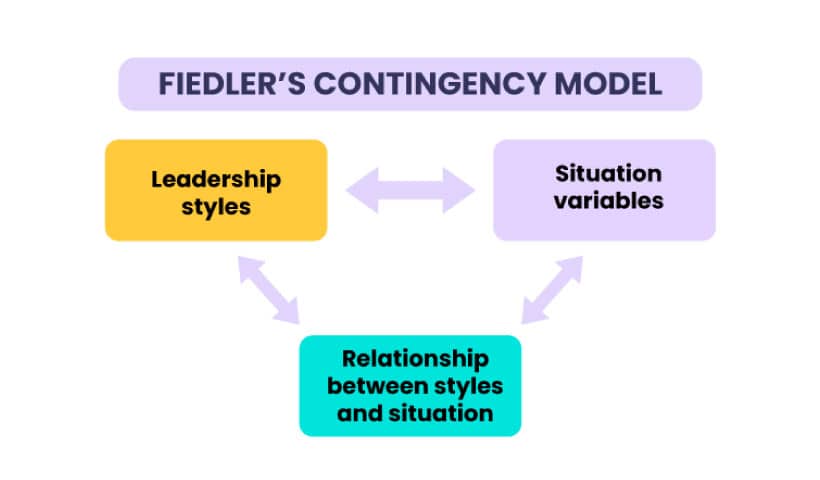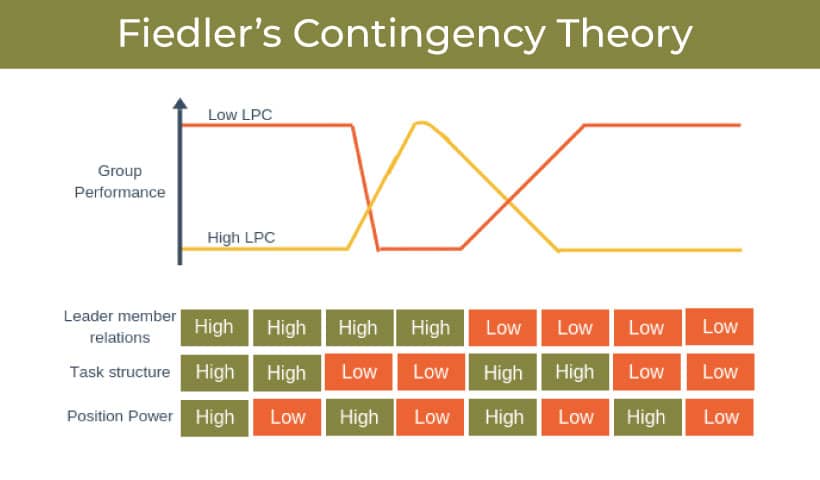In real-life scenarios, does the contingency theory of leadership pilot the leaders by example? Is it worthy enough to implement this theory in management? Oftentimes, we encounter those questions from the inquisitive folks. Answering the question will be efficacious if we aid you in exploring this theory completely. After that, you can cognize the whole aspects of this theory by yourself.
Certainly, being a better person is more exigent than becoming a leader. For instance, becoming more productive and less selfish can be verily emergent in dealing with the contingent states. In this case, this theory can aid the leaders in discerning the atmosphere accurately. After that, the leaders will be potent in managing hardship. So, let's unveil more about this leadership theory in the next lines.
What Is Contingency Theory of Leadership
Firstly, you must cognize this theory in an absolute form. Otherwise, the mood of implementing this leadership theory will seem a blur to you. In fact, this theory is very efficacious in dealing with troublesome states. Here, it holds that the leader's actions are contingent on the state and the followers' reactions to it. Thus, the leader's instruction and work may vary.
In other words, leaders antedate conceivable outcomes. Besides, they take steps to confirm that their followers are competent to thrive in the state of affairs. You know what; this theory has been used by prosperous leaders throughout history. It is because; the history of mankind points out that the states were always not in the grip of men. Therefore, they had to set a plan based on the state.
Most importantly, the above lines are the extract of the whole theory. The leaders should be potent and charismatic to forecast the upcoming moments. It does not connotate that they will always be entirely correct. This theory suggests that the leader's anticipation should tend to be almost similar to the real condition. In this way, they can set an apt plan of action for the betterment of the organization.
Advantages and Disadvantages of Contingency Theory of Leadership
Certainly, it is a malleable theory that can be applied in a variety of different situations. Consequently, it will store success in the triumph list of the organization. The theory carries enormous advantages for the leaders. Truly, those positive feedbacks pilot the organization towards amazing accomplishment. In this way, the theory is worth setting in managing the staff and followers.
Conversely, you will observe that this theory contains a few drawbacks as well. It is obvious that every theory appears to some lacking. We can resolve or overlook those things if the theory benefits us more evenly. Well, let's unearth all of the aspects in the following lines.
Advantages:
• Realistic View:
This theory delivers a realistic view of management and organization. Besides, it bids a tool to aid leaders in making enhanced decisions. This theory is crafted on the hypothesis that every state is diverse, which means that dissimilar actions will be obligatory in dissimilar situations. Leaders who imply contingency theory can therefore adapt their strategies as needed.
Thus, it aids them in being more current in their roles. Conversely, this theory points out that the leader is not in control of the whole thing. Besides, there are many contingencies that can distress the administrative outcomes. The leader must antedate these contingencies and plan engagements in order to optimize managerial aftermaths.
• Options for the Employees:
Certainly, this theory enhances the plausibility of growth for the employees. In today's hasty-paced world, employees are always craving ways to raise and share their ideas. In this aspect, this theory of leadership is such an exigent tool. You know what; it sets options for the employees. After that, it pilots them to flourish and contributes to the business.
In addition, it permits the business to endure malleable and adaptable. This aspect is exigent in a persistently fluctuating world. As a result, both the liveware and the business benefit from this approach. By setting options for the employees, this theory certifies the accomplishment.
• States-Oriented Management:
Here, the management structure can be the emergent aspect of this theory. Most importantly, it confirms that the management of the organization is situation-oriented and not stereotyped. It pilots them to retort effectively to fluctuating conditions.
In other words, this theory has appeared on a specific premise. It points out that the management’s behavior is inclined by the state in which they catch themselves. As a result, leaders must be persistently cognizant of the hard-hitting environment. Actually, it is the state in which the leaders work and set tunings to their behavior accordingly.
• Predictive Power:
Leaders must set decisions in an ever-changing milieu, and many times these decisions hinge on predicting future behavior. It is where the contingency theory of leadership emanates in to craft more skillful deeds. Truly, it provides leaders with an outline for discerning how folks will act in certain states.
Moreover, the leaders can then imply this evidence to craft plans and scenarios that account for potential conclusions. By doing so, leaders can make restored decisions. In addition, they can efficaciously certify that their officialdoms are prepared for whatsoever may come.
Disadvantages:
• Lack of Theoretical Base:
In some senses, this theory contains a few disadvantages as well. Firstly, you will unveil that it does not posits the abuzz pathway of leadership. The theory does not have a theoretical base and is instead based on the ideas of other leading thinkers. Consequently, it does not have a form of well-establishment in the milieu.
Oftentimes, it may not be precise in all states. Additionally, the theory is not pertinent for all sorts of leaders. The experts assert that the theory rolls up based on a number of empirical studies. Therefore, it does not store apt replication of the working process. Therefore, this flaw can pilot the organization and its employees towards hardship.
• Lack of Course of Action:
Secondly, we can shift your views on the lack of course of action in this theory. You know what; it does not advise a course of action. Rather, it theorizes that diverse levels of contingencies in the atmosphere. The milieu can be internal and external. It will encounter the staff with the diverse behaviors of leaders.
Here, it only trains the leaders to discern how they can adapt their deeds to varying states of affairs. But, the plan of action will just roll up based on the leader's mindset. Actually, they usually rely on the evidence and data at their disposal. There are no hard and fast rules. It is only guidelines that are based on the specific state and individual leader.
• Reactive But Not Proactive:
Well, you can define this theory as a reactive one but not a proactive one. It holds that leaders react to states and events rather than proactively influencing them. As a result, leaders are not proactive in predicting or inducing the future. They instead rely on past reactions to craft their decisions.
Leaders who employ this theory are typically volatile in their actions and decisions, as opposed to preemptive. In addition, they imply contingencies to covenant with hitches as they arise. Therefore, this theory does not bring the optimal aftermaths that an organization desires.
• Complex Approach:
Lastly, this theory is a complex approach that many leaders have been implying over the years. Above all, it rolls up grounded on the inkling that dissimilar circumstances seek a restored solution. This theory pilots the leaders to adopt a very complex and blur approach. Therefore, they cannot assert convincing success.
However, this complex approach takes the leader's situational perspective into account. Besides, it counts the separable faces to cognize their behavior. But, the whole process is verily ticklish. It is not facile for ordinary folks to discern and embrace this approach accurately. In this way, this approach tends to set intricate strategies as well.
Who Developed the Contingency Theory of Leadership?
Well, this theory was first familiarized in the 1960s by Professor Fred Fiedler, who is an Austrian psychologist. He asserted that a leader should be potent to antedate and fine-tune to changes in the milieu. Thus, they can fruitfully lead their team. In other words, a leader should be malleable and hasty to respond to variations. After that, the team can endure being prosperous.
Besides, he also believed that a leader should discern the folks. If the leaders are questing to lead them, they should associate with them on a personal level. Here, modifying themselves and relying on the milieu is the cotter way to grasp the plausible aftermaths. It means that apt leadership is not a static concept. But rather, it is repetitively evolving and altering as the leader acclimates to circumstances.

However, this theory posits that dissimilar statues ask for variance in piloting mood. Thus, the leaders can handle the pressure of the achievement. You know what; success is not an affair of self-acting. It just follows the verily piloting from the leaders. Here, Fiedler's theory just points to the process of doing or acquiring this process profoundly.
Fiedler's Contingency Theory of Leadership
Leadership is an intricate and challenging task. It requires not only the aptitude to pilot folks but also the knack to anticipate the next state. Fiedler's contingency theory of leadership is a model that aids leaders make sound decisions grounded on impulsive statuses. This theory explains how different conditions, familiar as contingencies, sway leadership behavior.

Above all, a leader must be certain regarding his steps. It is only plausible when he contains the efficacy of forecasting the future. Besides, he must be assertive and accurate in this affair. This theory suggests that a good leader is potent to acclimate to diverse deeds and strategies. By understanding Fiedler's theory, you will be commendable enough to set a better discernment of what crafts a good leader.
Most importantly, three key elements are exigent for a successful leader. For instance, we can name role clarity, role expectations, and role relationships. Leaders must be vibrant about their role and what they are in authority for. Besides, they must certify that their team members discern those potentials. In this way, the theory trains and pilots a leader to form his management efficiently.
Contingency Theory of Leadership Examples
In the world of business, the contingency theory of leadership is a favorite tool for managers. Actually, it is a framework that aids leaders in apprehending how people ponder, sense, and act. It has three core creeds, including folks who are irrationally driven, and variation produces opposition and the application of human resources. It has exemplary implications in the business.
To be an efficacious leader, you will entail being competent to acclimatize your tactics as indispensable. It is where contingency theory sets in the organization. Truly, it is a model that suggests that leaders should concoct for conceivable states. Besides, it is persistent in altering its policies accordingly. In this way, they can be more current in their parts and accomplish outlooks while still certifying the team.
Here, we can name Winston Churchill as the apt instance of implying this theory. He implicated this model of leadership to pilot Britain during World War II. The face of overwhelming odds has relied on contingency theory to get them through tough times. Besides, another name appears on the list for certain reasons. You have heard the name of John F. Kennedy.
Actually, he was the president of the USA. He applied this theory to accomplish the apt outcomes during the Cold War. In both cases, contingency theory aided these leaders in enduring persistence. Thus, they encountered every odd. In addition, they are in the very adjuration to face adversity and keep their morale high. These are apt examples of this theory's implication in the real field of the earth.
Conclusion
Altogether, the contingency theory of leadership is verily apt in handling the ticklish states. Thus, it certifies the accomplishment of the organization. You know what; a critical aspect of the guidance is the aptitude to ascertain and address contingencies. Certainly, it is exigent in any organization, as it lets leaders acclimate their course of action. However, this theory accurately fills the prerequisites of their employees and customers.








